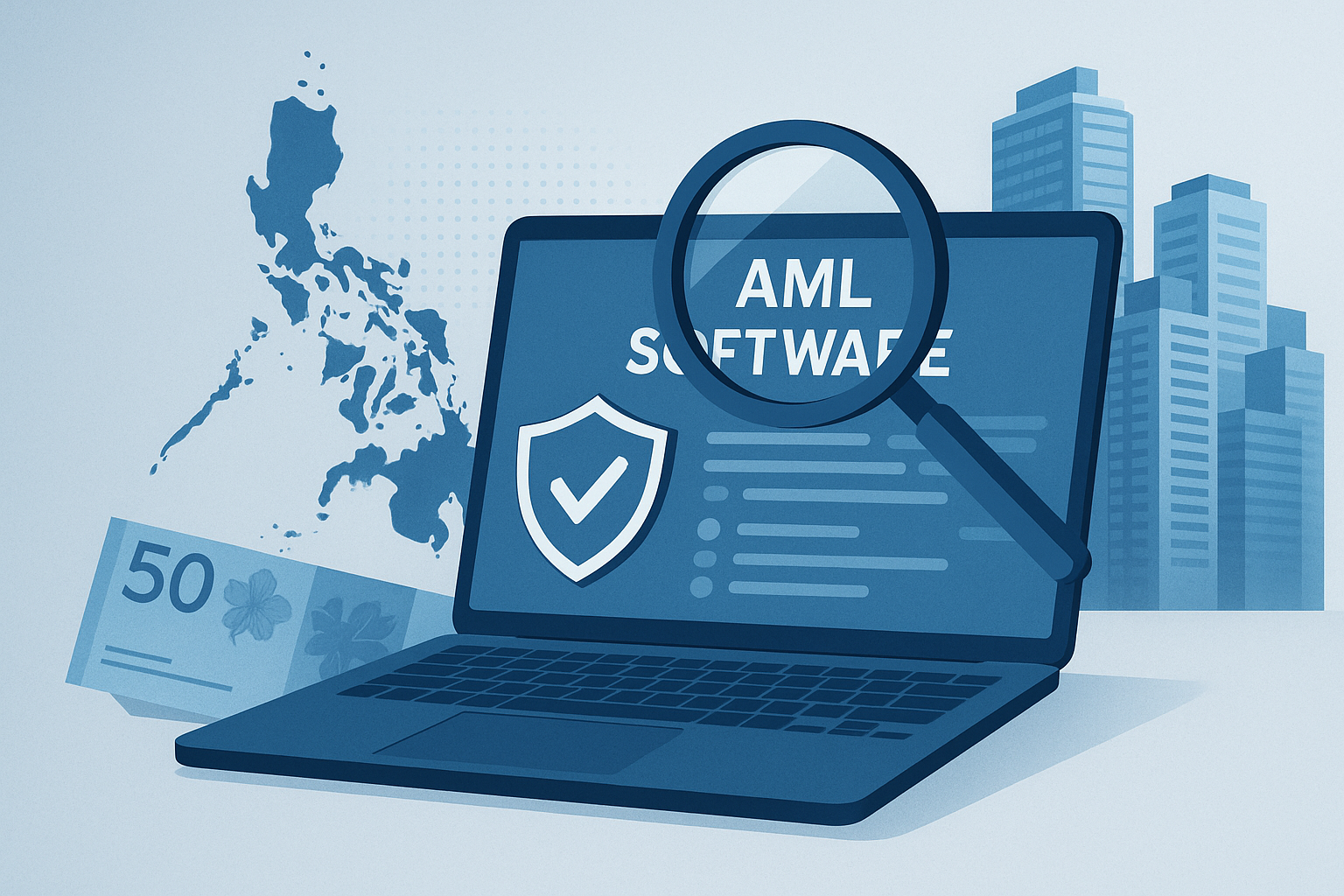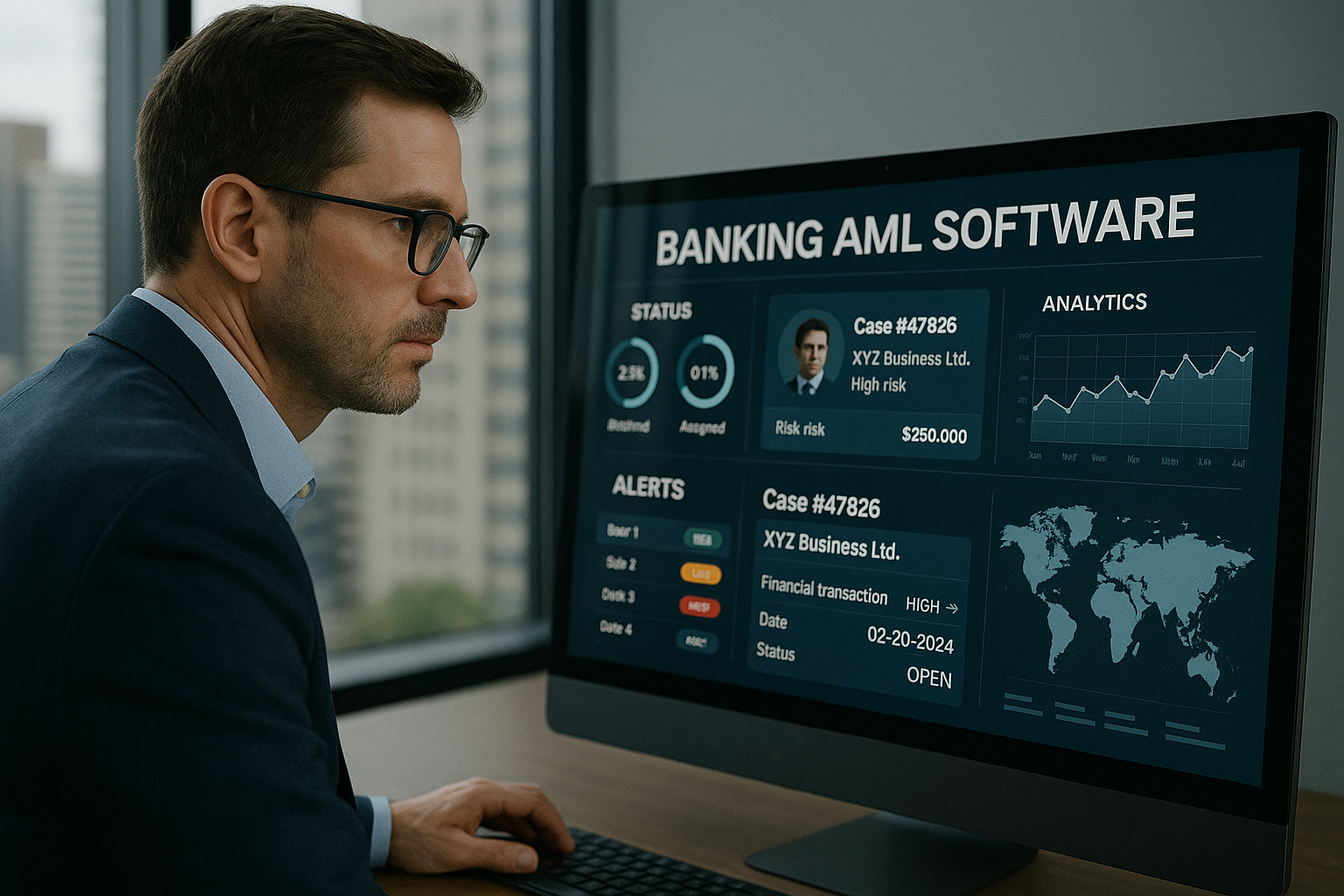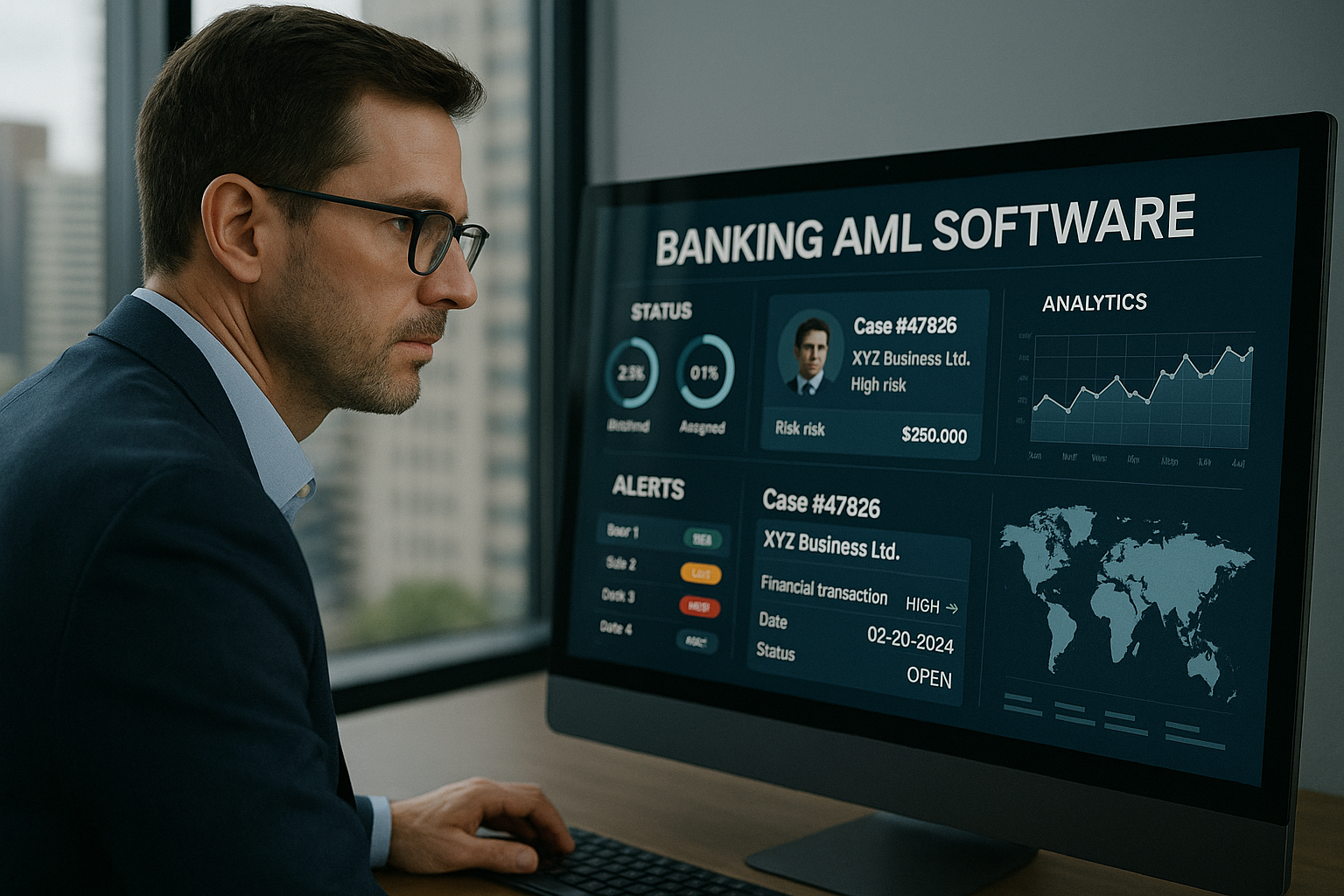AML Software Names: The Global Standards Redefined for Malaysia’s Financial Sector
.svg)
In the world of financial crime prevention, the right AML software name is not just a brand — it is a badge of trust.
Why AML Software Names Matter More Than Ever
Every financial institution today faces the same challenge: keeping up with the speed, scale, and sophistication of financial crime. From investment scams and mule accounts to cross-border layering and shell company laundering, the threats facing Malaysia’s financial system are multiplying.
At the same time, Bank Negara Malaysia (BNM) is tightening oversight, aligning with global standards set by the Financial Action Task Force (FATF). Compliance is no longer a tick-box exercise — it is a strategic function tied to an institution’s reputation and resilience.
In this environment, knowing and choosing the right AML software name becomes critical. It’s not just about software capability but about reliability, explainability, and the trust it represents.

What Does “AML Software” Really Mean?
Anti-Money Laundering (AML) software refers to systems that help financial institutions detect, investigate, and report suspicious transactions. These systems form the backbone of compliance operations and are responsible for:
- Monitoring transactions in real time
- Detecting anomalies and red flags
- Managing alerts and investigations
- Filing Suspicious Transaction Reports (STRs)
- Ensuring auditability and regulatory alignment
But not all AML software names deliver the same level of sophistication. Some are rule-based and rigid; others leverage machine learning (ML) and artificial intelligence (AI) to adapt dynamically to new threats.
The difference between a legacy AML tool and an intelligent AML platform can mean the difference between compliance success and costly oversight.
Why AML Software Selection is a Strategic Decision
Choosing the right AML software is not only about compliance — it is about protecting trust. Malaysian banks and fintechs face unique pressures:
- Instant Payments: DuitNow and QR-based systems have made real-time detection a necessity.
- Cross-Border Exposure: Remittance and trade-based laundering pose constant challenges.
- Digital Fraud: The surge in scams linked to social engineering, fake investments, and deepfakes.
- Resource Constraints: Rising compliance costs and talent shortages across the sector.
In this landscape, the right AML software name stands for assurance — assurance that the system can evolve as criminals evolve.
Key Attributes That Define Leading AML Software Names
When evaluating AML solutions, financial institutions must look beyond brand familiarity and assess capability. The most effective AML software names today are built on five key attributes.
First, intelligence and adaptability are essential. The best systems use AI and ML to detect new money laundering typologies as they emerge, reducing dependency on static rules. Second, explainability and transparency ensure that every alert generated can be traced back to clear, data-driven reasoning, a feature regulators value highly. Third, scalability matters. With the explosion of digital payments, software must handle millions of transactions per day without compromising performance.
Fourth, the software must offer end-to-end coverage — integrating transaction monitoring, name screening, fraud detection, and case management into one platform for a unified view of risk. Finally, local relevance is crucial. A system built for Western banks may not perform well in Malaysia without scenarios and typologies that reflect regional realities such as QR-based scams, cross-border mule accounts, and layering through remittance channels.
These qualities separate today’s leading AML software names from legacy systems that can no longer keep pace with evolving risks.
AML Software Names: The Global Landscape, Reimagined for Malaysia
Globally, several AML software names have built reputations across major financial institutions. However, many of these platforms were originally designed for large, complex banking infrastructures and often come with high implementation costs and limited flexibility.
For fast-growing ASEAN markets like Malaysia, what’s needed is a new kind of AML software — one that combines global-grade sophistication with regional adaptability. This balance is precisely what Tookitaki’s FinCense brings to the table.

Tookitaki’s FinCense: The AML Software Name That Defines Intelligence and Trust
FinCense, Tookitaki’s flagship AML and fraud prevention platform, represents a shift from traditional compliance tools to an intelligent ecosystem of financial crime prevention. It embodies the modern attributes that define the next generation of AML software names — intelligence, transparency, adaptability, and collaboration.
1. Agentic AI Workflows
FinCense uses Agentic AI, a cutting-edge framework where intelligent AI agents automate alert triage, generate investigation narratives, and provide recommendations to compliance officers. Instead of spending hours reviewing false positives, analysts can focus on strategic oversight. This has been shown to reduce investigation time by over 50 percent while improving accuracy and consistency.
2. Federated Learning through the AFC Ecosystem
FinCense connects to Tookitaki’s Anti-Financial Crime (AFC) Ecosystem, a global community of banks, fintechs, and regulators sharing anonymised typologies and scenarios. This federated learning model allows institutions to benefit from regional intelligence without sharing sensitive data.
For Malaysia, this means gaining early visibility into emerging laundering patterns identified in other ASEAN markets, strengthening the country’s collective defence against financial crime.
3. Explainable AI for Regulator Confidence
Transparency is a hallmark of modern compliance. FinCense’s explainable AI ensures that every flagged transaction comes with a clear rationale, giving regulators confidence in the system’s decision-making process. By aligning with frameworks such as Singapore’s AI Verify and BNM’s own principles of responsible AI use, FinCense helps institutions demonstrate accountability and integrity in their compliance operations.
4. End-to-End AML and Fraud Coverage
FinCense delivers comprehensive coverage across the compliance lifecycle. It unifies AML transaction monitoring, name screening, fraud detection, and case management in one cohesive platform. This integration provides a single view of risk, eliminating blind spots and improving overall detection accuracy.
5. ASEAN Market Fit and Local Intelligence
While FinCense meets global compliance standards, it is also deeply localised. Its AML typologies cover region-specific threats including QR code scams, layering through digital wallets, investment and job scams, and cross-border mule networks. By embedding regional intelligence into its models, FinCense delivers far higher detection accuracy for Malaysian institutions compared to generic, global systems.
How to Evaluate AML Software Names: A Practical Guide
When assessing AML software options, decision-makers should focus on six essential dimensions:
Start with AI and machine learning capabilities, as these determine how well the system can detect unknown typologies and adapt to emerging threats. Next, evaluate the explainability of alerts — regulators must be able to understand the logic behind every flagged transaction.
Scalability is another critical factor; your chosen software should process growing transaction volumes without performance loss. Look for integration capabilities too, ensuring that AML, fraud detection, and name screening operate within a unified platform to create a single source of truth.
Beyond technology, localisation matters greatly. Software built with ASEAN-specific typologies will outperform generic models in detecting risks unique to Malaysia. Finally, consider collaborative intelligence, or the ability to draw on insights from peer institutions through secure, federated networks.
When these six elements come together, the result is not just a tool but a complete financial crime prevention ecosystem — a description that perfectly fits Tookitaki’s FinCense.
Real-World Application: Detecting Layering in Cross-Border Transfers
Imagine a scenario where a criminal network uses a Malaysian fintech platform to move illicit funds. The scheme involves dozens of small-value transfers routed through shell entities and merchants across Singapore, Indonesia, and Thailand. Each transaction appears legitimate on its own, but together they form a clear layering pattern.
Traditional monitoring systems relying on static rules would likely miss this. They flag individual anomalies but cannot connect them across entities or geographies.
With FinCense, detection happens differently. Its federated learning models recognise the layering pattern as similar to a typology detected earlier in another ASEAN jurisdiction. The Agentic AI workflow then prioritises the alert, generates an explanatory narrative, and recommends escalation. Compliance teams can act within minutes, halting suspicious activity before it spreads.
This proactive detection reflects why FinCense stands out among AML software names — it transforms compliance from reactive reporting into intelligent prevention.
The Impact of Choosing the Right AML Software Name
The benefits of choosing an intelligent AML software like FinCense extend beyond compliance.
By automating repetitive processes, financial institutions can reduce operational costs and redirect resources toward strategic compliance initiatives. Detection accuracy improves significantly as AI-driven models reduce false positives while uncovering previously hidden risks.
Regulatory relationships also strengthen, since explainable AI provides transparent documentation for every alert and investigation. Customers, meanwhile, enjoy greater security and peace of mind, knowing their bank or fintech provider has the most advanced defences available.
Perhaps most importantly, a well-chosen AML software name positions institutions for sustainable growth. As Malaysian banks expand across ASEAN, having a globally trusted compliance infrastructure like FinCense ensures consistency, scalability, and resilience.
The Evolving Role of AML Software in Malaysia
AML software has evolved far beyond its original role as a regulatory safeguard. It is now a strategic pillar for protecting institutional trust, reputation, and customer relationships.
The next generation of AML software will merge AI-driven analysis, open banking data, and cross-institutional collaboration to deliver unprecedented visibility into financial crime risks. Hybrid models combining AI precision with human judgment will define compliance excellence.
Malaysia, with its strong regulatory foundations and growing digital ecosystem, is uniquely positioned to lead this transformation.
Why Tookitaki’s FinCense Leads the New Era of AML Software
Among AML software names, FinCense represents the balance between innovation and reliability that regulators and institutions demand.
It is intelligent enough to detect emerging risks, transparent enough to meet global audit standards, and collaborative enough to strengthen industry-wide defences. More importantly, it aligns with Malaysia’s compliance ambitions — combining BSA-grade sophistication with regional adaptability.
Malaysian banks and fintechs that adopt FinCense are not just implementing a compliance tool; they are building a trust framework that enhances resilience, transparency, and customer confidence.
Conclusion
As financial crime grows more complex, the significance of AML software names has never been greater. The right platform is not just about functionality — it defines how an institution safeguards its integrity and the wider financial system.
Among the names redefining AML technology globally, Tookitaki’s FinCense stands apart for its intelligence, transparency, and regional insight. It gives Malaysia’s financial institutions a proactive edge, transforming compliance into a strategic advantage.
The future of AML is not just about compliance. It is about building trust. And in that future, FinCense is the name that leads.
Experience the most intelligent AML and fraud prevention platform
Experience the most intelligent AML and fraud prevention platform
Experience the most intelligent AML and fraud prevention platform
Top AML Scenarios in ASEAN

The Role of AML Software in Compliance

The Role of AML Software in Compliance









